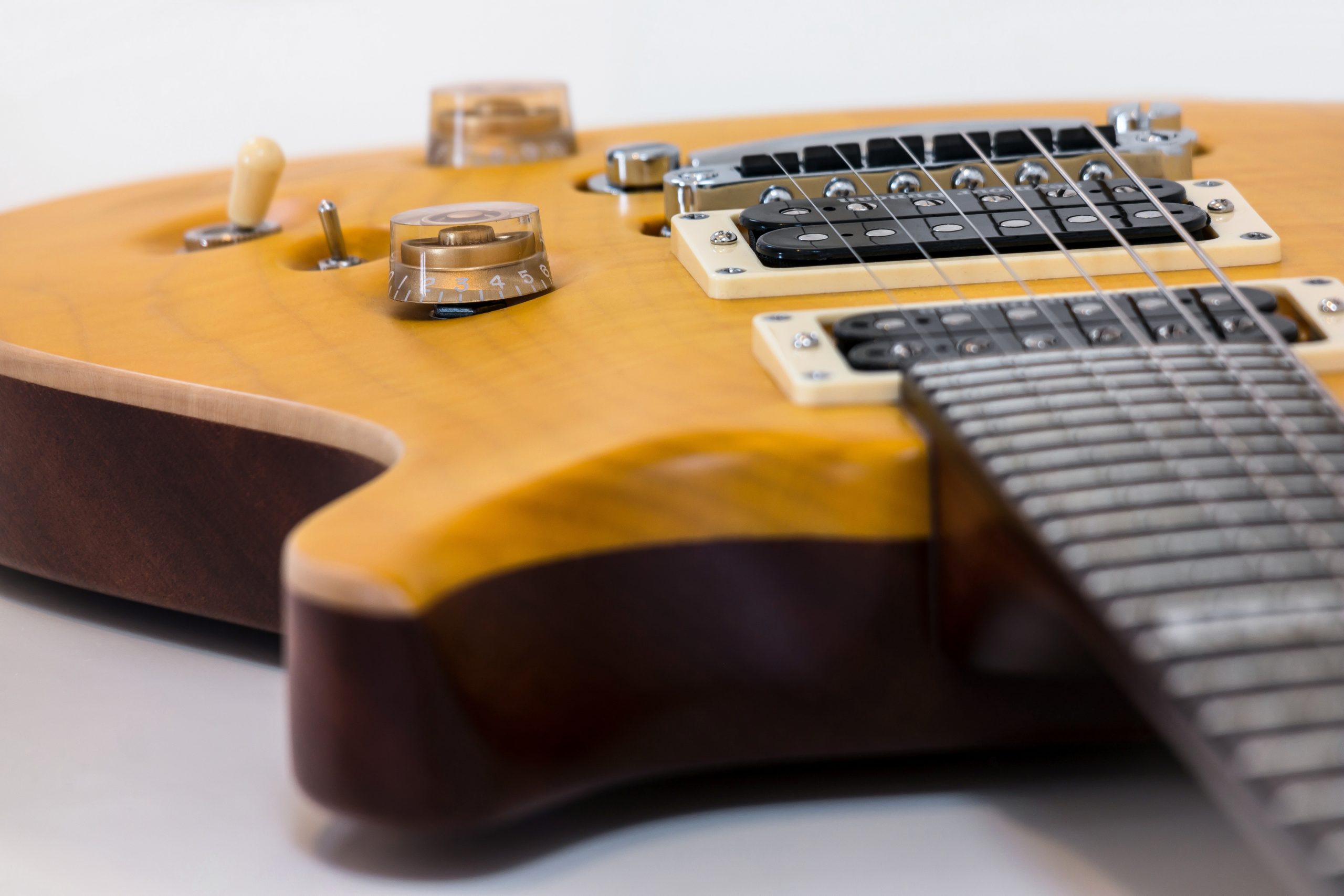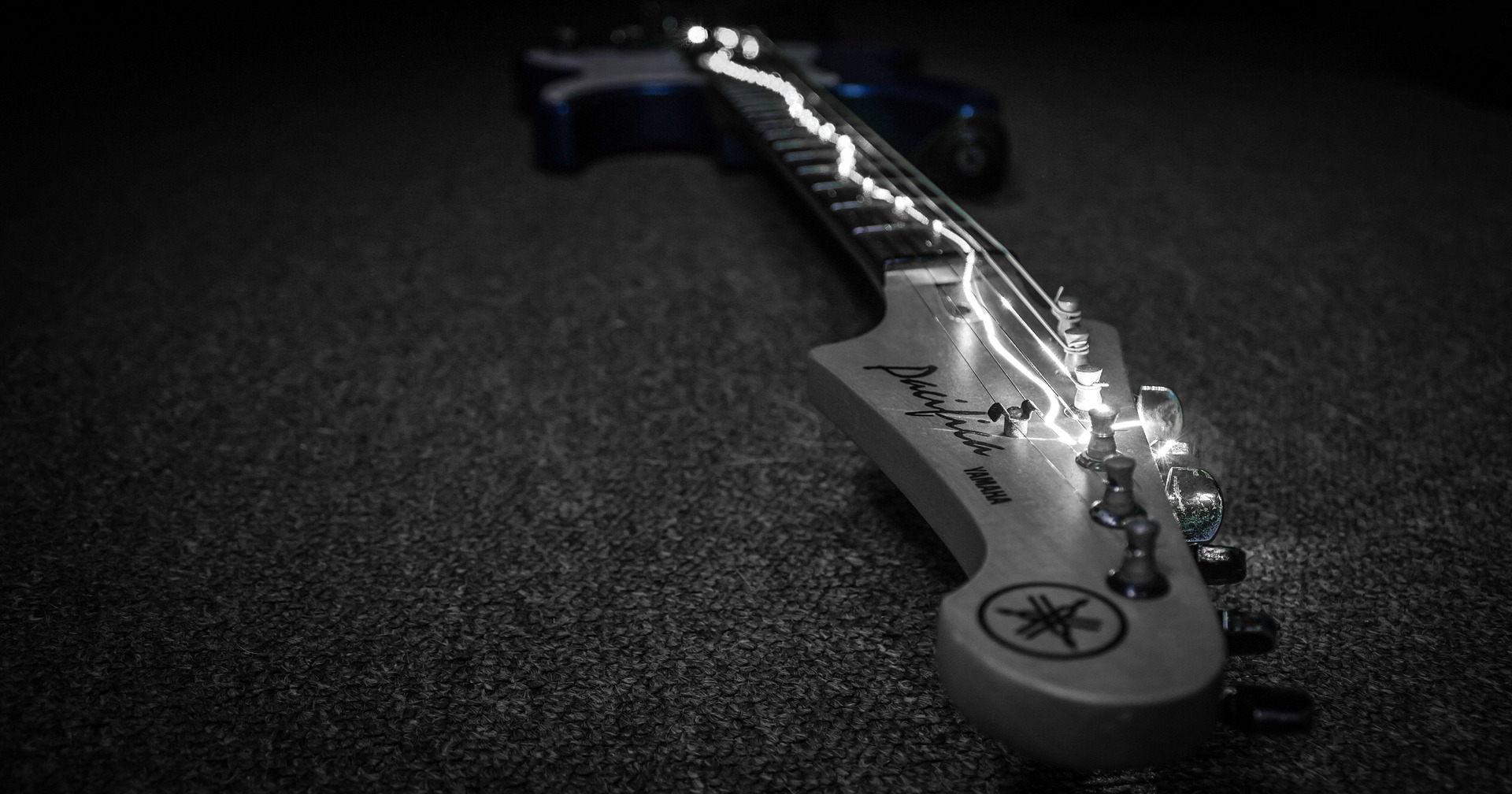Let’s continue our analysis by looking at more complex chords and their corresponding intervals. Minor 7 chords contain the intervals 1, ♭3, 5, ♭7 as you can see below.

Let’s take a look at our sound options again:
Minor Pentatonic: 1, ♭3, 4, 5, ♭7
Natural Minor: 1, 2, ♭3, 4, 5, ♭6, ♭7
Dorian: 1, 2, ♭3, 4, 5, 6, ♭7
Phrygian: 1, ♭2, ♭3, 4, 5, ♭6, ♭7 Harmonic Minor: 1, 2, ♭3, 4, 5, ♭6, 7
Melodic Minor: 1, 2, ♭3, 4, 5, 6, 7
As there’s a ♭7 in the chord, a natural 7 will clash with it, so we can rule out the Harmonic and Melodic minor scales in this case, which is not to say you can’t play a natural 7 over a minor 7 chord–of course you can–it’s just going to create a dissonant or chromatic sound. There’s no 6 in a Minor 7 chord so we can add one, the 4 is always good, as is the 2 or ♭2.
As we did in Part 5, loop the minor 7 chord and practice evoking the sound of the above scales by basing yourself in the 1, ♭3, 5 and adding in the relevant intervals. If you’ve been practicing this way, you should be getting some interesting results by now.
Writing out chord intervals vs writing out scale intervals
The next chord we’re going to look at is the Minor 9, which contains the intervals 1, ♭3, 5, ♭7, and 9. Don’t be thrown off by the 9 because it’s the same as the 2, it’s just written as a 9 because in the chord you’re playing a 2 in the next octave.

In our Minor 9 chord we still have a ♭7 and because the 9 is the same as the 2 the harmonic and melodic minor sounds are out, unless you want that dissonance, which is also what this series is about. In fact, I want you to hear these dissonances as everyone’s musical sensibilities are different.
What we do need to contemplate is adding in or emphasizing the 2, which in turn will make the ♭2 of the Phrygian sound clash, unless (again) you want that dissonance.
Minor Pentatonic: 1, ♭3, 4, 5, ♭7
Natural Minor: 1, 2, ♭3, 4, 5, ♭6, ♭7
Dorian: 1, 2, ♭3, 4, 5, 6, ♭7Phrygian: 1, ♭2, ♭3, 4, 5, ♭6, ♭7 Harmonic Minor: 1, 2, ♭3, 4, 5, ♭6, 7
Melodic Minor: 1, 2, ♭3, 4, 5, 6, 7
Again, practice soloing over the minor 9 chord by choosing what intervals to play or what scale sounds to evoke.
Next up is the Minor 6 chord I mentioned earlier.

The minor 6 is slightly confusing in that you’d think it would have a ♭6 in it but in fact it has the following intervals: 1, ♭3, 5, 6.
Our Minor 6 chord has no kind of 7 in it, so let’s see what sounds are available.
Minor Pentatonic: 1, ♭3, 4, 5, ♭7
Natural Minor: 1, 2, ♭3, 4, 5, ♭6, ♭7
Dorian: 1, 2, ♭3, 4, 5, 6, ♭7Phrygian: 1, ♭2, ♭3, 4, 5, ♭6, ♭7 Harmonic Minor: 1, 2, ♭3, 4, 5, ♭6, 7Melodic Minor: 1, 2, ♭3, 4, 5, 6, 7
You’ve probably already guessed that the ♭6 will clash with the natural 6 and so the Harmonic Minor and Phrygian sounds will create dissonance. As there’s no 7 in the chord, we can choose to add a ♭7 or a natural 7, and the natural 2 (or 9) sounds great over this chord. You can probably also see why the minor pentatonic nearly always works!
Let’s take a look at our penultimate chord, the Minor 11, which contains the intervals 1, ♭3, 5, ♭7, 9, 11.

The 4 here is the same as the 11, so our Minor 11 (technically) contains 6 different intervals, but here’s where they start getting left out in guitar chord forms for practical reasons. You still need to be aware of all the intervals in the chord because other instruments might be playing them.
What we really have here then are the following scale intervals: 1, 2, ♭3, 4, 5, ♭7. If you’ve been practicing with the previous chords, you should be fairly comfortable working with these intervals.
Please experiment with the more dissonant intervals like the natural 7 and the ♭2, especially if you’ve ever been taught to avoid them at all costs, as often happens with the right notes vs wrong notes approach to learning to improvise. By all means use them as chromatic or passing tones to get to the chord tones – especially now that you know which is which!
Our final chord for this part is the Minor 13, which contains the intervals 1, ♭3, 5, ♭7, 9, 11, 13.

The Minor 13 chord is where chords meet scales as if you write out the intervals as a scale you get: 1, 2, ♭3, 4, 5, 6, ♭7, which is the Dorian scale itself; and as you may have guessed, the 6 is the same as the 13. Our scale sounds are as follows:
Minor Pentatonic: 1, ♭3, 4, 5, ♭7 Natural Minor: 1, 2, ♭3, 4, 5, ♭6, ♭7
Dorian: 1, 2, ♭3, 4, 5, 6, ♭7Phrygian: 1, ♭2, ♭3, 4, 5, ♭6, ♭7 Harmonic Minor: 1, 2, ♭3, 4, 5, ♭6, 7Melodic Minor: 1, 2, ♭3, 4, 5, 6, 7
Again, the minor pentatonic will save you but as minor 13 chords are most often found in jazz and fusion, you can get away with playing pretty much any interval combination over it as long as it’s tasteful.
How can I get this going on the fretboard?
If you’ve been paying attention, you’ll have noticed that all our minor chords contain the intervals 1, ♭3, and 5, which is a minor triad, therefore, it makes sense to use minor triads as our basis for improvising. What’s more, triads are easy to find on the fly. In theory there are many minor triads on the fretboard, but in practice it’s only worth learning these three:

Why? They’re in the middle of the fretboard, which is a good place to start a solo, as well as being ideal for expanding outward either higher or lower, while covering most of the neck. Use these as your home base and add in the relevant intervals.
Other Minor Chords
We’ve looked in detail at the most common minor chords, but there are a few more you might come across. The idea of this series is to teach you how to do this kind of analysis so that you can be self-sufficient when it comes to analyzing a chord or chord progression and knowing what to play over it.
If you’re feeling adventurous, try the following minor chords:
Minor/Major 7: 1, ♭3, 5, 7
Minor 6/9: 1, ♭3, 5, 6, 9
Minor add9: 1, ♭3, 5, 9
In Part 7, we look at major chords/interval sounds.



